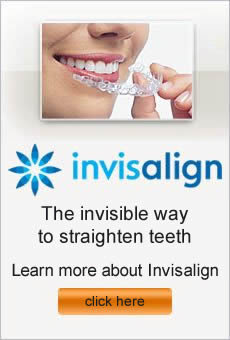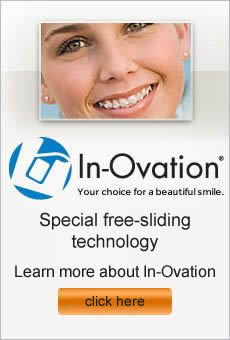You may not realize it, but orthodontic treatment can drastically change people’s lives. A healthy, straight smile improves your appearance and increases self-esteem and confidence. Insecurities about your smile could be holding you back from all kinds of things; a beautiful smile might give you just the edge on life that you need.
It doesn’t matter if you’re 16 or 60, a great smile is important. Age is really not a consideration for orthodontic treatment, especially with new advancements making treatment more and more discreet. So if you’re unhappy with your look and wonder if orthodontics can help, schedule an appointment with a qualified and experienced orthodontist to learn about the possibilities for your smile.
Most orthodontists offer a variety of options for treatment. These may include traditional metal braces, ceramic braces, lingual braces, Invisalign clear aligners and other appliances as appropriate. Ask your orthodontist about the best way to improve your smile, making sure to voice your concerns about treatment and the lifestyle that you hope to have during the process. For example, if diet restrictions are a big deal to you, then Invisalign removeable aligners might be appealing.
Some common issues that orthodontics helps with include:
• Crowded or overlapping teeth
• Spaces or gaps between teeth
• Overbite where the upper front teeth protrude over the lower ones
• Underbite where the lower teeth cover the upper teeth
• Open bite where the teeth do not touch normally
A good orthodontist will work with you to create a comprehensive treatment plan that achieves your smile goals. You’ll learn how to care for your mouth during the process so that your teeth remain healthy and strong. Then when treatment is complete, you’ll be able to display your new look proudly and enjoy it for a lifetime.
Part of the hassle associated with improving your teenager’s smile with braces is getting your teen to buy into the process. Many teens are very resistant to wearing braces because they don’t want a mouth full of metal, food stuck in their braces, or restrictions placed on their diets. Invisalign Teen is here to help!
Invisalign Teen involves wearing a series of aligners over the teeth that gently shift them into better positions. The clear plastic aligners are virtually invisible, which thrills teenagers who don’t want to bring attention to their braces. This also rules out the potential for food becoming stuck in wires or brackets, a common hazard that teens wearing traditional braces fear.
Another plus to Invisalign Teen is the aligners are removeable. They are removed for eating, so there are no restrictions on your teen’s favorite foods. They still have the freedom to eat treats like popcorn or hard candy without concern. Aligners are also removed for cleaning, so normal brushing and flossing win out as opposed to the difficulties cleaning around metal braces.
You won’t have to listen to your teen complain about discomfort with braces when you choose Invisalign. There are no painful adjustments and no pointy wires to poke them in the mouth. You also don’t need to worry that your teen doesn’t know when to change sets of aligners, because Invisalign Teen has a special Blue Dot Indicator that lets you know it’s time to switch. And if your teenager tends to be irresponsible, Invisalign Teen offer six free aligner replacements when one is lost.
The benefits of Invisalign Teen are obvious: invisible, removeable, comfortable, customized and effective. Your teen can’t complain that their social life is negatively impacted by wearing braces when you choose Invisalign as the method. It seems that teenagers face enough hardships and change in their lives; Invisalign Teen offers a stress-free, unique approach to a beautiful smile.
Moody teenagers can be hard to please, and sometimes finding out that they need braces can send them reeling. If you have a teen who needs orthodontic treatment but is fighting the idea of having a mouth full of metal, consider the latest innovation called Invisalign.
This revolutionary treatment involves wearing customized clear plastic aligners over your teeth. About every two weeks, you’ll transition to a new set of aligners in a series designed to gently move teeth into better positions. Invisalign corrects a variety of problems like overcrowding, gaps, crooked teeth, and bite issues.
If you’ve already heard about Invisalign, it may have been associated with adults. Although many adults love this treatment method, teens can enjoy it just as much. Others hardly notice you’re undergoing treatment and your self-esteem is not negatively impacted. It’s easy to smile your way through the process and end up with a perfect smile when treatment is done.
What are some aspects about Invisalign that make it such a low-stress orthodontic alternative?
• Traditional braces are unsightly and bulky, but Invisalign aligners are lightweight and practically invisible. Nothing beats Invisalign for the most aesthetic approach to treatment.
• It’s easy to keep your teeth and gums clean since the retainers are removed for brushing and flossing. Normal dental hygiene tasks are possible with this treatment method.
• There are no diet restrictions since the aligners are removed while eating. Teens can enjoy their favorite foods without being hampered by rules.
• No worrying that food is stuck in the metal brackets and wires of traditional braces.
• Emergency visits to the orthodontist are eliminated since there’s no chance of breaking a bracket or having a wire stabbing you in the mouth. Invisalign even provides extra retainers if one is lost to ensure uninterrupted treatment.
• The pain associated with traditional braces is not a factor with Invisalign, which uses gentle movement to reach your smile goals.
• Treatment time is typically not as long with Invisalign compared to traditional methods, with the average patient reaching their end goal in less than 18 months.
If your smile makes you unhappy because of problems like crooked teeth or a misaligned bite or large gaps, you may be anxious to correct your smile with braces. There are numerous options available for braces today such as traditional metal braces, ceramics, Invisalign and more. Once you and your orthodontist decide which treatment is best for you, it’s important to reserve time to repair any dental issues that might affect the success of your orthodontics before you get started.
Schedule an appointment with your dentist for a thorough checkup and professional cleaning prior to getting braces. If any of your teeth have decay that requires dental fillings, now is the time to have them done. You don’t want any extra teeth sensitivity due to decay, and having fillings completed may improve the fit and comfort of your braces. Also, it’s easier on both you and the dentist to perform the work without braces in your mouth.
Chips or cracks on your teeth should also be repaired at this time. You might need a dental crown or cap to best correct your problem. Have your dentist make the right corrections before you begin orthodontic treatment.
Wisdom teeth are a common culprit for problems with the spacing in your mouth. If you have wisdom teeth that have already erupted, it’s easy for your dental professional to tell if they should be extracted to achieve your ideal smile. If your wisdom teeth are impacted, it’s likely they should be removed prior to orthodontic treatment so that the process isn’t later ruined by your wisdom teeth coming in.
A professional teeth cleaning is an important step before getting braces. Brushing and flossing alone usually isn’t enough to eliminate all of the plaque buildup, tartar and bacteria that has accumulated on your teeth. Scaling and polishing is often necessary to make your teeth the best they can be prior to beginning orthodontic treatment. Even if you opt to go with Invisalign, your smile will look and feel better after a professional cleaning.
Once you have visited your dentist and had any necessary procedures completed, you can return to your orthodontist to begin your journey to a beautiful smile.
The best way to determine if an orthodontic treatment plan is right for you is to visit a qualified professional for a consultation. However, it’s also smart to go into the office with some knowledge about the options and questions that you might have. Being well-informed puts you on the road to a successful experience. If you’re wondering about Invisalign treatment, here are some common questions and answers about this method.
How does Invisalign work?
Unique 3D computer technology is used to create a treatment plan from the initial teeth position to the final desired position. Clear plastic aligners are developed based on the imaging in sets to be worn from the start of treatment and changed every couple of weeks to new sets as treatment progresses. This process gradually moves the teeth into better positions.
Who is a good candidate for Invisalign?
Most adults and teens are eligible for treatment, with the exception of those who still have too many baby teeth or are awaiting the eruption of second molars. Invisalign addresses most orthodontic issues, although a professional consultation is the best way to find out if it’s right for you.
What type of doctor should I see?
Special training is required to become an authorized Invisalign provider, as well as ongoing training classes to maintain the designation of “Preferred Provider.” This status may be achieved by a dentist or an orthodontist, so just look for a provider with the required Invisalign training.
Does Invisalign hurt?
The pain associated with traditional orthodontics does not occur with Invisalign, mainly because there are no wires involved. You may experience slight discomfort as you adjust to each new set of aligners, but it dissipates quickly and is not severe.
How will Invisalign affect my everyday life?
Since the aligners are removeable for eating and cleaning, you can stick to your regular diet and oral hygiene. Fewer appointments are required than with traditional braces, so you won’t even be giving up your time to sit in the dental chair. Your daily life will hardly be affected during Invisalign treatment.



